Picking your way through the large array of stoves that are currently available on the market can be a difficult process and choosing the perfect stove for the job isn't easy.
At Facewest we stock three main types of stove, LPG Canister stoves, Liquid Fuel and Multi Fuels Stoves. All three stove types are able to do similar things such as boil water for your morning coffee or cook your better half a camp cordon bleu meal; however some perform these tasks better than others. Also what stands each stove type apart is under which conditions they perform best.
Having a basic understanding of how each stove type works and in what environment they work best will help you decide which stove is best for you. Below is a brief description about each stove type.
Stove Types
There are 3 main stove type which we sell at Facewest; LPG Canister Stoves, Liquid Fuel Stoves and Multifuel Stoves. We also sell woodburning stoves, but I won't go into those in this article as they're a bit different.
LPG Canister Stoves (Liquid Petroleum Gas)
These are by far the simplest and easiest stoves to use and for the vast majority of people will be all they need. LPG stoves use a pressurised Gas canister that contains a mix of Propane, Butane, or Isobutene. The canister is screwed securely to the stove via a sealed thread, either directly on to the burner unit like the MSR Pocket Rocket or on to a hose that is then connected to the burner, similar to the Optimus Vega. Once the canister is attached simply turn the stove on, ignite, and hey presto you're cooking on gas! Each stove has a valve or dial that can be turned to regulate the flame height and intensity. Canister stoves are very light, packable and require next to no maintenance.
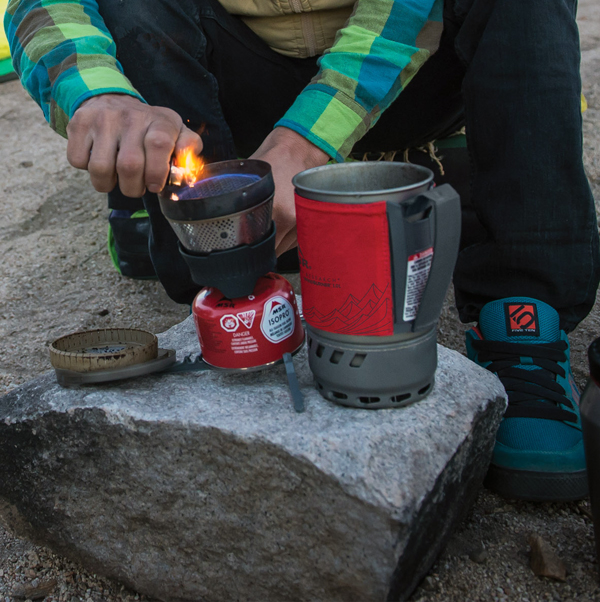
Igniting the MSR Windburner
There are a few different designs of canister stoves and they tend to fall into three categories.
1. One Pot Systems
The One Pot system was introduced by Jetboil a few years ago and since then other manufacturers have taken this simple idea and developed their own version of it. A One Pot System is exactly what the name suggests, the canister, burner, cook pot and lid fit together to make a simple compact cooking unit perfect for the adventure racer or light weight backpacker. Whilst they are great for boiling water, complex meals are not as easy to cook on them. Separate pot supports are available for some models meaning you then have the flexibility of using other cooking pots with them. Most one pot systems utilize a heat exchanger on their pots to increase performance meaning boil times are incredibly fast.
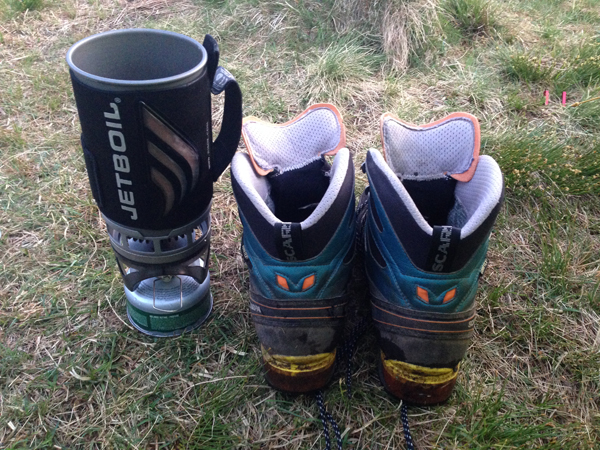
Jetboil Flash (and some boots)
2. Canister Mounted
These stoves all mount directly to the top of the canister. They are small, light and very easy to cook on. Stability can become an issue if a tall gas canister is used with a large pot.
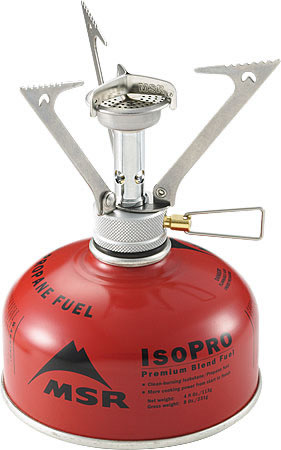
MSR Pocket Rocket
3. Hose Mounted
These stoves attach to the canister via a hose or fuel line, the burner units are free standing with legs to stabilise them. The legs fold away to make them nice and compact for transporting the stove. The lower centre of gravity means they very stable and are perfect for heavier pots and make cooking proper meals much easier and are ideal for larger groups.
Whilst canister stoves are great there are some downsides to them. In very cold temperatures and at higher altitudes the performances of the stoves reduce, sometimes to the point of not working at all. If you are going to be travelling at altitude or in very cold temperatures then a liquid/multi fuel stove would be a more suitable choice. The other major sticking point with a canister based stove is that in much of the remote areas of the world finding replacement canister can be difficult, so having a stove that only works with a gas canister can be very problematic.
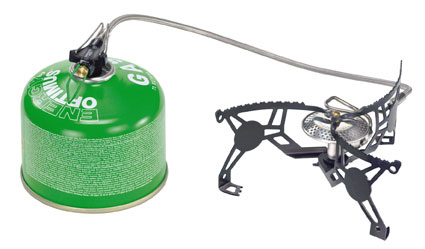
Optimus Vega
Liquid Fuel Stoves
Liquid fuel stoves are a little more complex than the canister based stove, they burn a variety of different fluids. The main types are Kerosene, Petrol, White gas & Diesel. Liquid fuel stoves are far cheaper to run than canister stoves, you also have the ability to work out how much fuel you will need for your trip and only take that with you. With gas canisters you always end up with half empty canister kicking around which either you don't use or you take with you on a trip along with a full canister in order to ensure you don't run out fuel. Don't forget canisters need to be brought home with you when they are empty to dispose of them! Pretty much all liquid fuel stoves are of a similar design. The burner heads are free standing and are attached to the fuel bottle via a fuel line. They are perfect for large groups and are used widely at high altitudes and in very cold environments.
MSR's video 'How to Use a Multi Fuel Stove'
Each stove will come with one or a number of different jets which will need to be changed depending on the fuel type that is being burnt. To light a liquid fuel stove the fuel needs to be pressurised, this is done be using a pump which is attached to the top of your fuel bottle. This pressure will turn the liquid fuel into a vapour so it can be burnt. The fuel is transferred from the fuel bottle along the fuel line to the burner head. In order to get the stove ignited the burner needs to be pre-heated or primed this is done by releasing a small amount of liquid fuel out onto either a priming pad or a priming cup. This fuel is ignited and will heat up the stove. Once the stove has been primed you can slowly release the fuel from your fuel bottle to your stove, the flame will then settle down and intensify and the stove will be ready to use. Each liquid stove ignites in a slightly different way so it is imperative to read the manufacturer's instructions before use.
Some fuels types such as diesel can be particularly dirty when burnt, they can leave soot and grime on the stove which in turn can block the jets. If this happens you will simply need to dismantle your stove and give it a good clean, this will maintain the performance of the stove. The process of igniting the stove along with the cleaning and maintenance may put you off a liquid or multi fuel stove, especially if you're used to the ease of use of a canister based stove. However for some this is the fun and integral part of owning this style of stove.
Multifuel Stoves
Whilst Liquid only and Multi Fuel stoves are different they are at their heart very much the same. A Multi Fuel or Gas and Liquid stove simply has the ability to attach a Gas canister to the stove as well as being able to burn liquid fuels. This makes multi fuel stove incredibly versatile and the perfect choice for people who travel a lot or for people who wish to have one stove that will do everything.
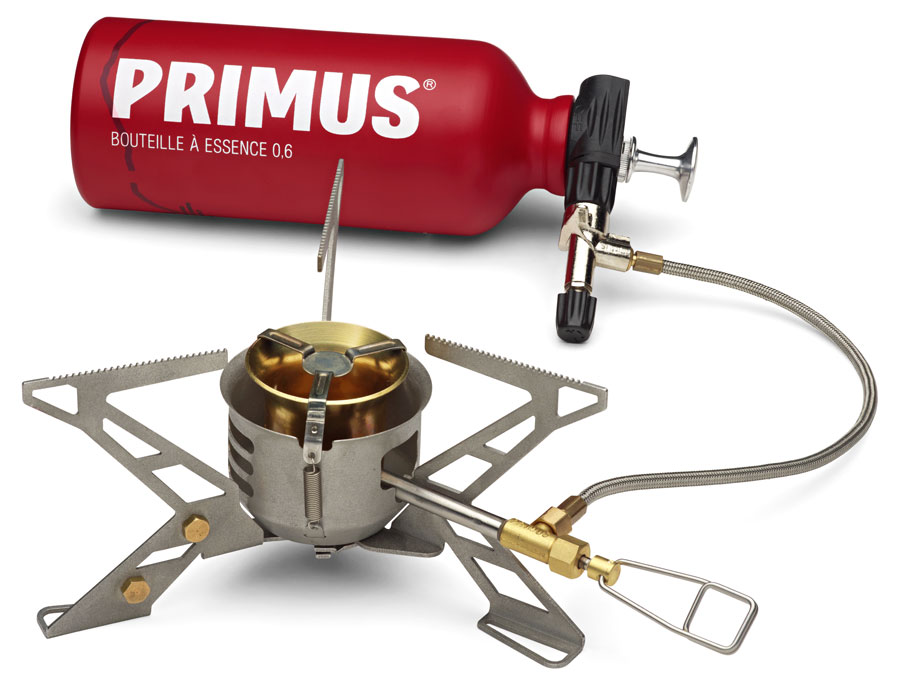
Primus Omnifuel Ti
What Type of Chef are You?
Now we know how each stove type differs and how they work, knowing when and where you are going to be using your stove will hopefully help you choose the right one.
For example if you usually only ever go away for weekends to facilitated campsite in the UK a Liquid stove is going to be a tad overboard, on the flip side however, if you often travel to remote regions backpacking a Jetboil is probably not going to be the most suitable choice.
In my opinion there are three types of camp stove users, Fast and Light, Backpackers, and Remote Traveller/Mountaineer. Many of us will fit into more than one of these user groups and if this is the case you may want a different stove for every possible occasion, is this really a bad thing!?
Fast and Light
The Fast and Light users are people such as Adventure racers, Minimalist Backpackers, Alpinists and Big Wall climbers. These people need a light, compact stove that will boil water as fast as possible. They will most probably be eating freeze dried meals and at some point may want to melt snow for a brew. Ideal stoves for this group are canister based One Post systems such as a Jetboil or MSR Windburner or an extremely light stove such as the Crux lite which can be paired with a titanium cook pot to keep the weight to a minimum.
Backpackers/Weekend Campers
Ease of use, simple, straight forward stoves are ideal for this group of people. Users will typically be out for a couple of nights at a time and will possibly be cooking more complex meals than the Fast & Light user. The lightest stoves will not necessarily be the first choice here but something more stable and robust with the ability to use a wide range of pot sizes. The Optimus Vega or the Primus Express Spider II would be perfect. Also stove sets are the perfect solution here, the Primus Spider Stove set comes with the stove, wind shield, 1 litre cook pot and nesting bowl, which is suitable for 1-2 people.
Remote Traveller/Mountaineer
This type of users will want a stove that can burn a wide variety of fuels types, be very economical and also will also need to be field maintainable if it breaks. Mountaineers, Backpackers and Cycle Tourists who are heading to remote areas are the types of users here. Liquid and Multi Stoves are nearly always the only option as they are robust and very efficient. The best stoves would be the tried and tested Whisperlite Universal or the Primus Omni Fuel II.
Conclusion
For the vast majority of people a canister based stove will be the most convenient and suitable stove. They are perfect for weekends away camping, backpacking or cycle touring. The ease of use makes cooking up an evening meal a doddle, also the low weight and bulk makes them easy to stow away. If you are someone who travels further afield to more remote locations a better option would be to go for a multi fuel stove, that way you have the ability to swap between Gas and Liquid fuels when needed. There will be a small majority of people who demand much more from their stove such as camping at higher altitudes or travelling to Polar Regions. If this is you then a stove designed to perform at its best in these conditions is the only option.
Hopefully this article has helped you choose a stove that is perfect for your needs. However if you still have any questions drop us an email or give us a call, we are always happy to help. Details in the footer below.
